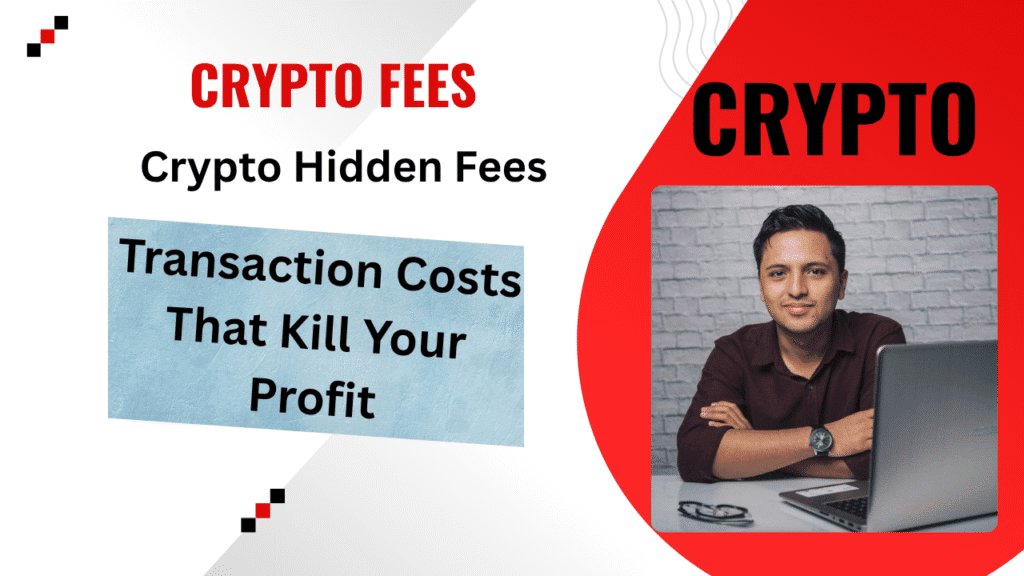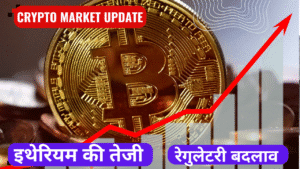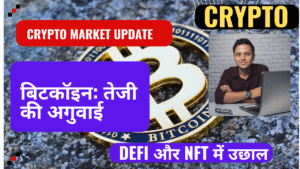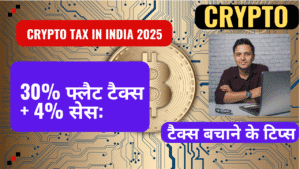
Crypto Hidden Fees: Investing or trading in the world of cryptocurrency has become very popular these days. But behind its glitz and glamour, there are some hidden fees that new investors are often unaware of. Especially when it comes to transaction fees, they can swallow a significant portion of your investment. Whether you are buying, sending, receiving, or withdrawing cryptocurrency, you have to pay fees at every step. In some cases, up to 40-50% of a ₹1000 transaction can be lost to fees. In this blog, we will discuss in detail five major hidden transaction fees associated with cryptocurrency and also explain how to reduce these fees. This blog is especially for those who are new to crypto or want a deeper understanding of this field. So, let’s get started!
1. Crypto Hidden Fees: Your First Stop
When you start investing in cryptocurrency, the first step is to create an account on a crypto exchange. In India, people often use Indian Rupees (INR) to buy crypto, and for this, they rely on exchanges like Binance, WazirX, or CoinDCX. But did you know that every exchange charges various types of fees? Let’s understand these fees:
Deposit and Withdrawal Fees
When you deposit money from your bank account to an exchange or sell crypto and send the money back to your bank, you have to pay deposit and withdrawal fees. For example, if you deposit via card using Euros on Binance, you may have to pay a 2% fee. If you use a bank transfer, this fee could be 1%. The same applies to Indian Rupees. If you deposit INR, you need to check the exchange’s fee list to see how much is charged.
Similarly, when you sell your crypto and withdraw money to your bank, a withdrawal fee applies. For instance, on Binance, for INR withdrawals, you may have to pay a fixed amount or a percentage-based fee. This fee varies across exchanges, so you should carefully check your exchange’s fee structure.
Crypto Hidden Fees: Trading Fees
If you are an active trader and frequently buy and sell, trading fees matter a lot to you. For example, on Binance, if you don’t have a premium plan, you have to pay a 0.1% trading fee on every buy or sell. If you do instant buy/sell, this fee can be even higher. However, if you use Binance’s own token (BNB), you can get a 25% discount.
For those trading in India, another thing to note is the 1% TDS (Tax Deducted at Source). This applies to every transaction, and you have to pay it mandatorily. If you do day trading, this fee can significantly reduce your profits. But if you invest for the long term, like swing trading (where you hold for weeks or months), this fee doesn’t matter as much.
Ways to Save
- Check the exchange’s fee structure: Every exchange has a fee section on its website. Read it carefully and choose an exchange with lower fees.
- Invest for the long term: If you don’t trade frequently, the impact of trading fees will be less.
- Use the exchange’s token: For example, using BNB on Binance can get you a discount on trading fees.
- Choose low-fee payment methods: Use cheaper options like bank transfers instead of credit cards.
2. Network and Gas Fees: The Backbone of Blockchain
The foundation of cryptocurrency is blockchain technology. Blockchain is a digital ledger where all transactions are recorded. But when you send crypto from one wallet to another, you have to pay a network fee or gas fee. This fee goes to the nodes (validators) that validate transactions on the blockchain.
What is Gas Fee?
Gas fee is the cost you pay to process a transaction on the blockchain. This fee depends on the type of blockchain and the network’s congestion. For example:
- Solana: Gas fees on the Solana blockchain are very low, like 0.0115 Solana (about a few cents).
- Ethereum: Gas fees on the Ethereum blockchain can range from $1 to $20, especially when network traffic is high.
You can check live gas fees on websites like Etherscan. For example, if you are sending a token on the Ethereum blockchain, the average fee might be 9 cents. But during peak hours, it can go up to $5-$10.
Ways to Save
- Use low-fee blockchains: Blockchains like Solana, Polygon, or Binance Smart Chain have much lower fees than Ethereum.
- Check network congestion: Visit websites like Etherscan or mempool.space to see when network traffic is low. Transacting at night (especially during US night hours) can reduce fees.
- Manually set gas fees: In wallets like Metamask, you can manually lower the gas fee. Although this may slow down the transaction, it will save on fees.
3. Swapping Fees: The Cost of Changing Tokens
Swapping means converting one crypto token into another. For example, if you have Ethereum and want to convert it to USDC, you will swap. This process often happens through decentralized exchanges (like Uniswap) or wallets (like Metamask, Phantom).
How Do Swapping Fees Work?
During swapping, you have to pay two types of fees:
- Wallet Fee: The wallet you are using (e.g., Phantom) charges a small fee for swapping.
- Network Gas Fee: Since swapping is also a blockchain transaction, you have to pay a gas fee. For example, if you swap on the Ethereum blockchain, the gas fee can be 0.006-0.007 ETH.
Ways to Save
- Choose low-fee DEXs: Compared to Uniswap, platforms like PancakeSwap or SushiSwap may have lower fees.
- Use Layer-2 solutions: Swap on Layer-2 solutions like Arbitrum or Optimism instead of Ethereum, where gas fees are much lower.
- Batch Swapping: If you want to swap multiple tokens, do them in a batch instead of multiple individual swaps.
4. Bridging Fees: From One Blockchain to Another
Bridging means transferring tokens from one blockchain to another, but within different layers of the same blockchain. For example, sending tokens from Ethereum’s mainnet to Arbitrum (a Layer-2 solution). This process is useful when you want to move from an expensive blockchain (like Ethereum) to a cheaper one (like Arbitrum).
What is Bridging Fee?
During bridging, you have to pay a gas fee to move the transaction from the mainnet to Layer-2. For example, sending tokens from Ethereum to Arbitrum may cost $0.64 and take 15 minutes. But once on Arbitrum, transaction costs become very low (less than 10 cents).
Ways to Save
- Use Layer-2 solutions: Transact on Layer-2 solutions like Arbitrum, Optimism, or Polygon, where fees are very low.
- Check bridging platforms: Some bridging platforms (like Hop Protocol) may be cheaper than others.
- Bridge during low congestion: Check gas fees on Etherscan and bridge during low-traffic times.
5. Cross-Chain Fees: Between Different Blockchains
Cross-chain transfer happens when you send tokens from one blockchain to a completely different blockchain. For example, sending tokens from the Ethereum blockchain to Cardano or Sui blockchain. This process is complex and involves multiple steps, like sending tokens to a DEX, converting them, and then transferring to the target blockchain.
How Do Cross-Chain Fees Work?
For example, if you want to send USDC from Ethereum to Sui blockchain as DAI, you may have to pay several fees:
- DEX fee (e.g., Uniswap or Rango Exchange)
- Gas fees (on both Ethereum and Sui blockchains)
- Bridging platform fee
Platforms like Rango Exchange can tell you how much time and fees will be involved. For example, a $100 transaction may cost $1.5 and take 1.5 minutes. If you can wait 25 minutes, the fee might reduce to $1.38.
Ways to Save
- Use cheap cross-chain bridges: Compare platforms like Rango Exchange, Stargate, or Across and choose the cheapest option.
- Transfer during low congestion: Check gas fees on both blockchains and transact during low-traffic times.
- Use batch transfers: If you need to send multiple tokens to different chains, send them together to reduce fees.
Additional Ways to Save on Fees
Now that we’ve covered all the major fees, let’s look at some general ways to reduce your transaction fees:
- Use Layer-2 Solutions: As mentioned, Layer-2 solutions like Arbitrum, Optimism, and Polygon are much cheaper than Ethereum. Check on CoinMarketCap which blockchains your token supports and use the cheaper ones.
- Batch Transfers: If you need to send the same token to multiple people, use batch transfer platforms (like MultiSender). This sends tokens to multiple addresses in a single transaction, reducing gas fees.
- Transact at Night: Especially during US night hours when network congestion is low. Check live gas fee data on Etherscan or mempool.space.
- Manually Set Gas Fees: In wallets like Metamask, you can customize gas fees. If you’re not in a hurry, set a lower gas fee.
- Use Secure Wallets: Don’t keep your crypto in software wallets (like Metamask) for too long. Use hardware wallets (like Ledger or Trezor), which are more secure.
Keep Your Crypto Secure
Saving on fees is important, but so is the security of your crypto. Some tips:
- Use Hardware Wallets: These store your tokens offline, reducing the risk of hacking.
- Avoid Phishing: Don’t click on unknown links and never share your wallet’s private key.
- Enable 2FA: Use two-factor authentication (2FA) on your exchange and wallet accounts.
Conclusion
Transaction fees are an essential part of the cryptocurrency world, but with the right knowledge and strategy, you can significantly reduce these fees. In this blog, we discussed five major fees—exchange fees, network/gas fees, swapping fees, bridging fees, and cross-chain fees—in detail. We also saw how methods like using Layer-2 solutions, batch transfers, and transacting during low-congestion times can reduce your costs.
If you’re new to crypto or already investing, understanding these fees and applying savings methods will help increase your profits. Did you learn about any new fees? Or do you have any other questions? Comment below and let us know. Also, if you want deeper insights into crypto, stay tuned with us. The crypto world is exciting, but with the right knowledge, you can make it even more profitable!
- Crypto Market Update: Bitcoin Mein Asthirta, Ethereum Ki Tezi, Aur Regulatory Badlaav
 Crypto Market Update में आपका स्वागत है! आज का दिन क्रिप्टो बाजार में उत्साह और उतार-चढ़ाव से भरा रहा। हम बिटकॉइन की अस्थिरता, इथेरियम की शानदार तेजी, और मिड-कैप टोकन्स के प्रदर्शन को देखेंगे। साथ ही, संस्थागत निवेश, रेगुलेटरी अपडेट्स, और डीफाई की प्रगति पर भी नजर डालेंगे। आइए, क्रिप्टो की दुनिया में ताजा अपडेट्स… Read more: Crypto Market Update: Bitcoin Mein Asthirta, Ethereum Ki Tezi, Aur Regulatory Badlaav
Crypto Market Update में आपका स्वागत है! आज का दिन क्रिप्टो बाजार में उत्साह और उतार-चढ़ाव से भरा रहा। हम बिटकॉइन की अस्थिरता, इथेरियम की शानदार तेजी, और मिड-कैप टोकन्स के प्रदर्शन को देखेंगे। साथ ही, संस्थागत निवेश, रेगुलेटरी अपडेट्स, और डीफाई की प्रगति पर भी नजर डालेंगे। आइए, क्रिप्टो की दुनिया में ताजा अपडेट्स… Read more: Crypto Market Update: Bitcoin Mein Asthirta, Ethereum Ki Tezi, Aur Regulatory Badlaav - Crypto market Update : Weekly Market Update and Insights
 Crypto market Update में आपका स्वागत है, जो cryptocurrency की दुनिया की हर खबर के लिए आपका प्रमुख स्रोत है! इस सप्ताह Crypto market ने जबरदस्त उत्साह और तेजी के साथ शुरुआत की है। प्रमुख एसेट्स में तेजी का रुझान देखा जा रहा है, और निवेशक उत्साह से भरे हुए हैं। यह विस्तृत ब्लॉग नवीनतम… Read more: Crypto market Update : Weekly Market Update and Insights
Crypto market Update में आपका स्वागत है, जो cryptocurrency की दुनिया की हर खबर के लिए आपका प्रमुख स्रोत है! इस सप्ताह Crypto market ने जबरदस्त उत्साह और तेजी के साथ शुरुआत की है। प्रमुख एसेट्स में तेजी का रुझान देखा जा रहा है, और निवेशक उत्साह से भरे हुए हैं। यह विस्तृत ब्लॉग नवीनतम… Read more: Crypto market Update : Weekly Market Update and Insights - Crypto Tax in India 2025 – Complete Guide for Spot & Derivatives Traders
 Crypto Tax in India 2025 : भारत में Cryptocurrency Trading और निवेश तेजी से लोकप्रिय हो रहा है। Bitcoin, इथेरियम, सोलाना जैसे Crypto Tax में निवेश करने वाले लोग न केवल मुनाफा कमा रहे हैं, बल्कि इसके साथ आने वाली जटिल टैक्सेशन प्रणाली को भी समझने की कोशिश कर रहे हैं। 2025 में Crypto Taxation… Read more: Crypto Tax in India 2025 – Complete Guide for Spot & Derivatives Traders
Crypto Tax in India 2025 : भारत में Cryptocurrency Trading और निवेश तेजी से लोकप्रिय हो रहा है। Bitcoin, इथेरियम, सोलाना जैसे Crypto Tax में निवेश करने वाले लोग न केवल मुनाफा कमा रहे हैं, बल्कि इसके साथ आने वाली जटिल टैक्सेशन प्रणाली को भी समझने की कोशिश कर रहे हैं। 2025 में Crypto Taxation… Read more: Crypto Tax in India 2025 – Complete Guide for Spot & Derivatives Traders - Crypto Market Update : Crypto Market Mein Bada Badlav, US Retirement Funds Mein Crypto Ko Mili Manzoori
 नमस्कार, Crypto Market Update पर आपका स्वागत है। आज का दिन क्रिप्टो निवेशकों के लिए बेहद खास है, क्योंकि अमेरिका में एक ऐतिहासिक फैसले ने Cryptocurrency को पारंपरिक निवेश की मुख्यधारा में लाने का रास्ता खोल दिया है। इस लेख में हम इस बड़े फैसले के प्रभाव, बाजार के रुझानों, प्रमुख क्रिप्टोकरेंसी की कीमतों, संस्थागत… Read more: Crypto Market Update : Crypto Market Mein Bada Badlav, US Retirement Funds Mein Crypto Ko Mili Manzoori
नमस्कार, Crypto Market Update पर आपका स्वागत है। आज का दिन क्रिप्टो निवेशकों के लिए बेहद खास है, क्योंकि अमेरिका में एक ऐतिहासिक फैसले ने Cryptocurrency को पारंपरिक निवेश की मुख्यधारा में लाने का रास्ता खोल दिया है। इस लेख में हम इस बड़े फैसले के प्रभाव, बाजार के रुझानों, प्रमुख क्रिप्टोकरेंसी की कीमतों, संस्थागत… Read more: Crypto Market Update : Crypto Market Mein Bada Badlav, US Retirement Funds Mein Crypto Ko Mili Manzoori - Tangem Wallet Se Karo Apne Crypto Ko Lock – No Hack, No Tension!
 Tangem Wallet को जानिए – एक सुरक्षित और आसान Cold wallet समाधान, जो आपके क्रिप्टो इनवेस्टमेंट को लंबे समय तक सुरक्षित रखने में मदद करता है। इसकी खासियतें, फायदे और 21+ ज़रूरी सवालों के जवाब जानें – ताकि आप अपने क्रिप्टो को पूरी समझदारी और भरोसे के साथ मैनेज कर सकें। आज के समय में… Read more: Tangem Wallet Se Karo Apne Crypto Ko Lock – No Hack, No Tension!
Tangem Wallet को जानिए – एक सुरक्षित और आसान Cold wallet समाधान, जो आपके क्रिप्टो इनवेस्टमेंट को लंबे समय तक सुरक्षित रखने में मदद करता है। इसकी खासियतें, फायदे और 21+ ज़रूरी सवालों के जवाब जानें – ताकि आप अपने क्रिप्टो को पूरी समझदारी और भरोसे के साथ मैनेज कर सकें। आज के समय में… Read more: Tangem Wallet Se Karo Apne Crypto Ko Lock – No Hack, No Tension!




